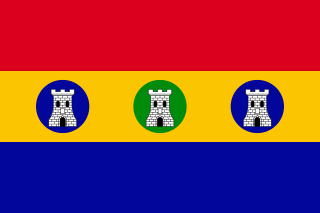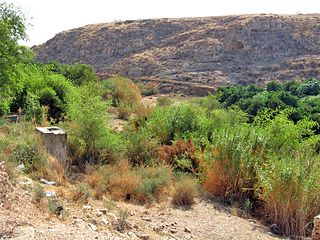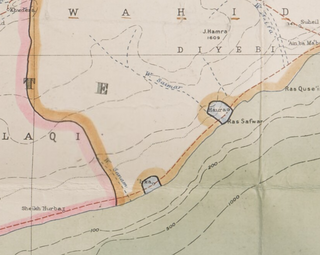Al-Hajarayn | |
|---|---|
 | |
 | |
| Country | |
| Governorate | Hadhramaut |
| Time zone | UTC+3 (Yemen Standard Time) |
Al-Hajarayn or Hagarein [1] is a village in east-central Yemen. It is located on the Wadi Kasr, in the lower part of the Wadi Duan. [1]
Al-Hajarayn | |
|---|---|
 | |
 | |
| Country | |
| Governorate | Hadhramaut |
| Time zone | UTC+3 (Yemen Standard Time) |
Al-Hajarayn or Hagarein [1] is a village in east-central Yemen. It is located on the Wadi Kasr, in the lower part of the Wadi Duan. [1]

In the 1890s, Theodore Bent and his wife, Mabel Bent, visited Al-Hajarayn. At the time, it was ruled by Sultan Abdul M'Barrek Hamout al Kaiti. Bent stated that although the Sultan was "not entirely under Makalla [ Qu'aiti]" despite being under their influence. [2] By 1901, Al-Hajarayn had fallen under Qu'aiti rule alongside the rest of Wadi Duan. [3]

Hadhramaut is a geographic region in the southern part of the Arabian Peninsula which includes the Yemeni governorates of Hadhramaut, Shabwa and al-Mahra, as well as Aden, Abyan and Lahij. Some sources also include Dhofar Governorate, in southwestern Oman, and Shaurah, in Najran Province, in southern Saudi Arabia. The name is of ancient origin, and is reflected in the name of the Yemeni Governorate of Hadhramaut. The people of Hadhramaut are called the Hadharem. They formerly spoke Hadramautic, an old South Arabian language, but they now predominantly speak Hadhrami Arabic.

Seiyun is a city in the region and Governorate of Hadhramaut in Yemen. It is located in the middle of the Hadhramaut Valley, about 360 km from Mukalla, the capital of Mukalla District and the largest city in the area, via western route. It is 12 km from Shibam and 35 km from Tarim, the other large cities in the valley.

Mukalla, officially the Mukalla City District, is a seaport and the capital city district of Yemen's largest governorate, Hadhramaut. The city is in the southern part of the Arabian Peninsula on the Gulf of Aden, on the shores of the Arabian Sea, about 480 kilometres east of Aden. It is the most important port city in the Hadhramaut region. It is also the sixth-largest city in Yemen, with a population of approximately 595,000 as of 2023. The city is served by the nearby Riyan International Airport.

Qu'aiti, or the Qu'aiti Sultanate of Shihr and Mukalla, was a sultanate in the Hadhramaut region of the southern Arabian Peninsula, in what is now Yemen. Its capital was Mukalla, and it was divided into six provinces, namely Al-Mukalla, Ash-Shihr, Shibam, Du'an, the Western Province and Hajr. Apart from Al-Mukalla, Ash-Shihr and Shibam were the Sultanate's major cities.

Kathiri, officially the Hadhrami Kathiri Dynasty in Seiyun or the Sultanate of Seiyun, was a sultanate in the Hadhramaut region of the southern Arabian Peninsula, in what is now part of Yemen and the Dhofari region of Oman.

Tafilah is one of the governorates of Jordan, located about 180 km south-west of Amman, Jordan's capital.

Al-Shihr, also known as ash-Shir or simply Shihr, is a coastal town in Hadhramaut, eastern Yemen. Al-Shihr is a walled town located on a sandy beach. There is an anchorage but no docks; boats are used. The main export is fish oil. The town is divided in two by a wādi called al-Misyāl. The western quarter is called Majraf and the eastern al-Ramla. As of 1997, it had several souqs (markets), including Sūq al-Lakham, Sūq al-Hunūd, and Sūq Shibām.

Wahidi Balhaf, or the Wahidi Sultanate of Balhaf in Hadhramaut, was one of several Wahidi states in the British Aden Protectorate. It was previously part of the Federation of Arab Emirates of the South, and then of its successor, the Federation of South Arabia when it was known simply as Wahidi.

Qatana is a city in southern Syria, administratively part of the Qatana District of Rif Dimashq Governorate. Qatana has an altitude of 879 meters. According to the Syria Central Bureau of Statistics, the city had a population of 33,996 in the 2004 census. It is the administrative center of the Qatana Subdistrict, which contained 20 localities with a collective population of 147,451 in 2004.
ʿAydhab was an important medieval port on the west coast of the Red Sea. The abandoned site of the town is located in the Halaib Triangle, a territory disputed between Egypt and the Sudan.
Al-Huwaylah is a village in east-central Yemen. It is located in the Hadhramaut Governorate.
Husun As Salasil A small village in the middle of Wadi Jabba, the land of Al Awamer, east of Yemen. It is located in the Hadhramaut Governorate.
Wadi al-Taym, also transliterated as Wadi el-Taym, is a wadi that forms a large fertile valley in Lebanon, in the districts of Rachaya and Hasbaya on the western slopes of Mount Hermon. It adjoins the Beqaa Valley running north to south towards the Jordan Valley where it meets the northwest corner of Lake Huleh. Watered by the Hasbani river, the low hills of Wadi al-Taym are covered with rows of silver-green olive trees with the population in the area being predominantly Druze and Sunni, with a high number of Christians, mostly Greek Orthodox. Wadi al-Taym is generally considered the "birthplace of the Druze faith".
The Al Kathiri also known as Alkaseri is a royal family that has had strong influence in the south of the Arabian Peninsula. It is one of the largest tribes of Banu Hamdan Hadramawt in eastern Yemen and Oman, with populations in Saudi Arabia, Qatar, United Arab Emirates, and East African countries such as Somalia and Kenya and Tanzania as well as Iran mainly concentrated in the most Arabic populated province of the country Khuzestan. However, there are two tribes of Al Kathiri one is Banu Hamdan and one is Banu Lam tribe, which is descendant from Tayy tribe, is located in Najd - northern Saudi Arabia - Kuwait - Iraq, and branched to Al Kathran (الكثران), Al Mughira (المغيرة), Al Fadhuol (الفظول) and Al Dhafeer (الظفير).

Wadi al-Far'a or Tirzah Stream is a stream in the northern West Bank that empties into the Jordan River south of Damia Bridge. It is the largest stream in the West Bank. Wadi al-Far'a is located in the rugged area of the West Bank and cuts east through the Jordan Valley, passing through the Palestinian village of Wadi al-Far'a. The Tirzah Reservoir is used to collect the floodwater of Wadi al-Far'a before it flows into the Jordan River.

Fort Al-Ghwayzi, or Al-Ghwaizi Fortress, is one of the old fortresses in Al-Mukalla, the capital of Hadhramaut Governorate in Yemen. It is considered an architectural masterpiece built on the foot of a rock designed to protect the city from Bedouin attacks.

The Sheikhdom of al-Hawra was a state of the Protectorate of South Arabia which existed from the 19th century to 1951. It became a British protectorate in 1888.

Tarim is a historic town situated in Wadi Hadhramaut, Yemen. It is widely acknowledged as the theological, juridical, and academic center of the Hadhramaut Valley. An important center of Islamic learning, it is estimated to contain the highest concentration of descendants of the Islamic Prophet Muhammad known as the Sadah anywhere in the world. The city is distinguished for producing numerous Islamic scholars, including Imam al-Haddad. Additionally, Tarim is also home to Dar al-Mustafa, a well-known educational institution for the study of traditional Islamic Sciences.

The Qu'aiti Sultan Palace is a historical palace located in Mukalla, Yemen. It was built in 1925 under the rule of sultan Ghalib bin Awadh al-Qu'aiti and it served as the residence of every ruling Sultan of the Qu'aiti Sultanate since.

Banu Nahd is an Arab tribe with historical presence across the Arabian peninsula. They trace their lineage to Nahd bin Zayd of the Quda'a confederation, traditionally considered Qahtanite from Himyar. However, there is historical debate, as some sources suggest Quda'ah descends from Ma'ad bin 'Adnan. Recent DNA studies indicate that tribes from Quda'ah, including Banu Nahd, align with the Adnanite lineage, challenging earlier claims of Qahtanite origins. This has led to reconsideration of their genealogical classification.